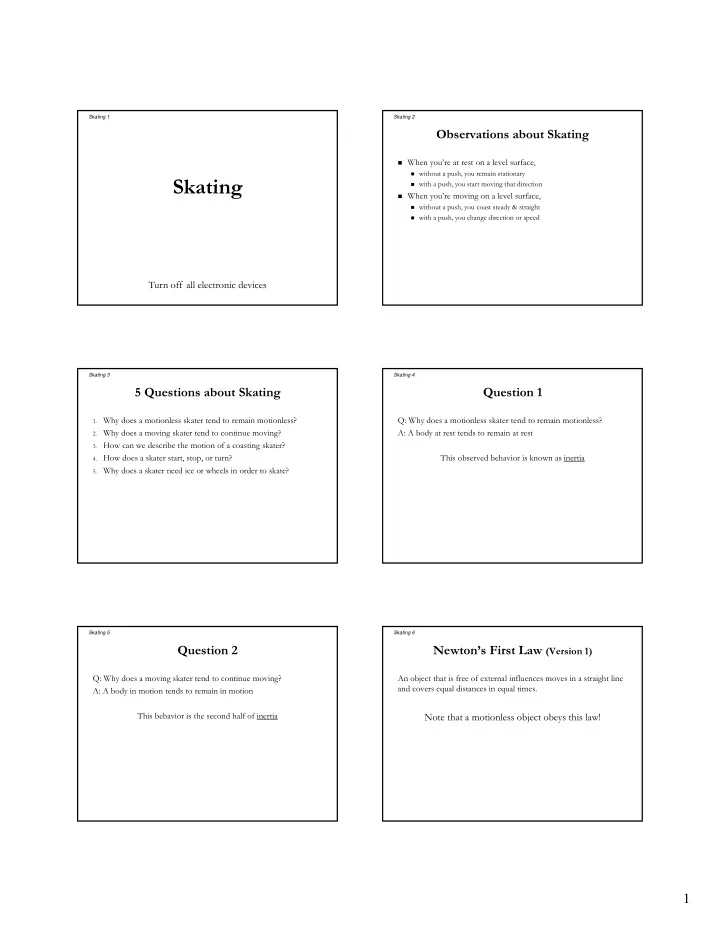

Skating 1 Skating 2 Observations about Skating When you’re at rest on a level surface, without a push, you remain stationary Skating with a push, you start moving that direction When you’re moving on a level surface, without a push, you coast steady & straight with a push, you change direction or speed Turn off all electronic devices Skating 3 Skating 4 5 Questions about Skating Question 1 1. Why does a motionless skater tend to remain motionless? Q: Why does a motionless skater tend to remain motionless? 2. Why does a moving skater tend to continue moving? A: A body at rest tends to remain at rest 3. How can we describe the motion of a coasting skater? 4. How does a skater start, stop, or turn? This observed behavior is known as inertia 5. Why does a skater need ice or wheels in order to skate? Skating 5 Skating 6 Question 2 Newton’s First Law (Version 1) Q: Why does a moving skater tend to continue moving? An object that is free of external influences moves in a straight line and covers equal distances in equal times. A: A body in motion tends to remain in motion This behavior is the second half of inertia Note that a motionless object obeys this law! 1
Skating 7 Skating 8 Question 3 Physical Quantities Q: How can we describe the motion of a coasting skater? 1. Position – an object’s location A: The skater moves at a constant speed in a constant direction 2. Velocity – its change in position with time Both are vector quantities: Position is distance and direction from a reference Velocity is speed and direction of motion, relative to a reference Skating 9 Skating 10 Newton’s First Law (Version 2) Another Physical Quantity An object that is free of external influences moves at a constant 3. Force – a push or a pull velocity. Force is another vector quantity: Note that a motionless object is “moving” at the amount and direction of the push or pull Net force is the vector sum of all forces on an object a constant velocity of zero! Skating 11 Skating 12 Newton’s First Law Question 4 An object that is not subject to any outside forces moves at a Q: How does a skater start or stop moving? constant velocity. A: A net force causes the skater to accelerate! 4. Acceleration – change in velocity with time 5. Mass – measure of object’s inertia Acceleration is yet another vector quantity: the rate and direction of the change in velocity 2
Skating 13 Skating 14 Newton’s Second Law About Units An object’s acceleration is equal to the net force exert on it divided SI or “metric” units: by its mass. That acceleration is in the same direction as the net Position → m (meters) force. Velocity → m/s (meters-per-second) Cause Acceleration → m/s 2 (meters-per-second 2 ) Force → N (newtons) Mass → kg (kilograms) Newton’s second law relates the units: Effect Resistance to cause Traditional form: net force = mass acceleration F = ma Skating 15 Skating 16 Question 5 Summary about Skating Q: Why does a skater need ice or wheels to skate? Skates can free you from external forces A: Real-world complications usually mask inertia When you experience no external forces, You coast – you move at constant velocity Solution: minimize or overwhelm complications If you’re at rest, you remain at rest If you’re moving, you move steadily and straight To observe inertia, therefore, When you experience external forces work on level ground (minimize gravity’s effects) You accelerate – you move at a changing velocity use wheels, ice, or air support (minimize friction) Acceleration depends on force and mass work fast (overwhelm friction and air resistance) 3
Recommend
More recommend